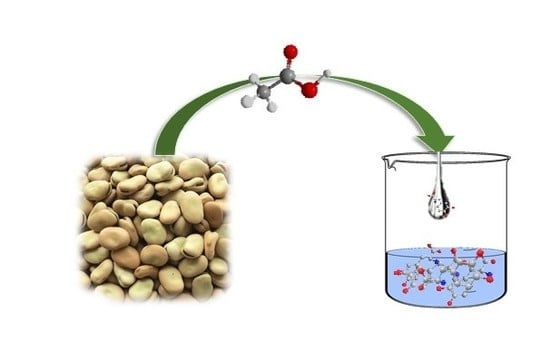Development of a Sustainable, Simple, and Robust Method for Efficient l-DOPA Extraction
Abstract
:1. Introduction
2. Results and Discussion
2.1. Optimization of the Extraction Conditions
2.1.1. Extraction Solvent
2.1.2. Extraction Time
2.1.3. Sonication Time Prior to Extraction and Number of Extraction Runs with Different Solid/Solvent Ratios
2.1.4. Sample Pre-Conditioning
2.2. Validation of the Best L-DOPA Extraction Conditions
2.3. L-DOPA Extraction from Dry Faba Beans
2.4. L-DOPA Extraction from Food Products
l-DOPA Stability
3. Materials and Methods
3.1. Plant Materials and Chemicals
3.2. Determination of the Best Conditions for l-DOPA Extraction
3.3. Extraction of L-DOPA from Food
3.4. Influence of Thermal Pre-Conditioning on L-DOPA Stability
3.5. Chemical Analysis
3.5.1. Faba Bean Dry Mass Analysis
3.5.2. HPLC Analysis
3.6. Statistical Analysis
3.7. Uncertainty Analysis
4. Conclusions
Author Contributions
Funding
Conflicts of Interest
References
- Jankovic, J. Levodopa strengths and weaknesses. Neurology 2002, 58, S19–S32. [Google Scholar] [CrossRef] [PubMed]
- Fahn, S. Description of Parkinson’s disease as a clinical syndrome. Ann. NY Acad. Sci. 2003, 991, 1–14. [Google Scholar] [CrossRef] [PubMed]
- Pugalenthi, M.; Vadivel, V. l-Dopa (l-3,4-dihydroxyphenylalanine): A non-protein toxic amino acid in Mucuna pruriens seeds. Food 2007, 322–343. [Google Scholar]
- Pulikkalpura, H.; Kurup, R.; Mathew, P.J.; Baby, S. Levodopa in Mucuna pruriens and its degradation. Sci. Rep. 2015, 5, 11078. [Google Scholar] [CrossRef] [PubMed]
- Baranowska, I.; Płonka, J. Simultaneous determination of biogenic amines and methylxanthines in foodstuff—sample preparation with HPLC-DAD-FL analysis. Food Anal. Methods 2015, 8, 963–972. [Google Scholar] [CrossRef]
- FAO Food and Agriculture Organization of the United Nations. Agriculture Database. 2016. Available online: http://www.fao.org/faostat/en/#data/QC (accessed on 22 October 2018).
- Purves, R.W.; Zhang, H.; Khazaei, H.; Vandenberg, A. Rapid analysis of medically relevant compounds in faba bean seeds using FAIMS and mass spectrometry. Int. J. Ion Mobil. Spectrom. 2017, 20, 125–135. [Google Scholar] [CrossRef]
- Etemadi, F.; Hashemi, M.; Randhir, R.; ZandVakili, O.; Ebadi, A. Accumulation of l-DOPA in various organs of faba bean and influence of drought, nitrogen stress, and processing methods on l-DOPA yield. Crop J. 2018, 6, 426–434. [Google Scholar] [CrossRef]
- Cardador-Martínez, A.; Maya-Ocaña, K.; Ortiz-Moreno, A.; Herrera-Cabrera, B.E.; Dávila-Ortiz, G.; Múzquiz, M.; Martín-Pedrosa, M.; Burbano, C.; Cuadrado, C.; Jiménez-Martínez, C. Effect of roasting and boiling on the content of vicine, convicine and l-3,4-dihydroxyphenylalanine in Vicia faba L. J. Food Qual. 2012, 35, 419–428. [Google Scholar] [CrossRef]
- Serjeant, E.P.; Dempsey, B. Ionisation Constants of Organic Acids in Aqueous Solution; Serjeant, E.P., Dempsey, B., Eds.; Pergamon Press: Oxford, UK, 1979. [Google Scholar]
- Gdala, J.; Buraczewska, L. Chemical composition and carbohydrate content of several varieties of faba bean and pea seeds. J. Anim. Feed Sci. 1997, 123–135. [Google Scholar] [CrossRef]
- Kirakosyan, A.; Kaufman, P.B.; Duke, J.A.; Warber, S.; Bolling, S. The production of l-DOPA and isoflavones in seeds and seedlings of different cultivars of Vicia faba L. (fava bean). Evidence-Based Integr. Med. 2004, 1, 131–135. [Google Scholar] [CrossRef]
- Safety data sheet 3,4-Dihydroxyphenylalanine—Product Information, Product Number D 9628. Sigma Aldrich. Available online: https://www.sigmaaldrich.com/catalog/product/sigma/d9628?lang=zhregion=CN (accessed on 22 June 2019).
- Basma, A.N.; Morris, E.J.; Nicklas, W.J.; Geller, H.M. l-DOPA cytotoxicity to PC12 Cells in culture is via its autoxidation. J. Neurochem. 2002, 64, 825–832. [Google Scholar] [CrossRef]
- Randhir, R.; Shetty, K. Light-mediated fava bean (Vicia faba) response to phytochemical and protein elicitors and consequences on nutraceutical enhancement and seed vigour. Process Biochem. 2003, 38, 945–952. [Google Scholar] [CrossRef]
- Dhanani, T.; Singh, R.; Shah, S.; Kumari, P.; Kumar, S. Comparison of green extraction methods with conventional extraction method for extract yield, l-DOPA concentration and antioxidant activity of Mucuna pruriens seed. Green Chem. Lett. Rev. 2015, 8, 43–48. [Google Scholar] [CrossRef]
- Casazza, A.A.; Aliakbarian, B.; Perego, P. Recovery of phenolic compounds from grape seeds: Effect of extraction time and solid–liquid ratio. Nat. Prod. Res. 2011, 25, 1751–1761. [Google Scholar] [CrossRef] [PubMed]
- Zhou, Y.Z.; Alany, R.G.; Chuang, V.; Wen, J. Studies of the rate constant of l-DOPA oxidation and decarboxylation by HPLC. Chromatographia 2012, 75, 597–606. [Google Scholar] [CrossRef]
- Siddhuraju, P.; Becker, K. Rapid reversed-phase high performance liquid chromatographic method for the quantification of l-DOPA (l-3,4-dihydroxyphenylalanine), non-methylated and methylated tetrahydroisoquinoline compounds from Mucuna beans. Food Chem. 2001, 72, 389–394. [Google Scholar] [CrossRef]
- Diallo, O.K.; Berhe, T. Processing of Mucuna for human food in the Republic of Guinea. Trop. Subtrop. Agroecosystems 2002, 1, 193–196. [Google Scholar]
- Huang, T.; Jander, G.; De Vos, M. Non-protein amino acids in plant defense against insect herbivores: Representative cases and opportunities for further functional analysis. Phytochemistry 2011, 72, 1531–1537. [Google Scholar] [CrossRef]
- Soares, A.R.; Marchiosi, R.; Siqueira-Soares, R.; Siqueira-Soares, R.D.C.; Barbosa de Lima, R.; Dantas dos Santos, W.; Ferrarese-Filho, O. The role of l-DOPA in plants. Plant Signal. Behav. 2014, 9, e28275. [Google Scholar] [CrossRef]
- Randhir, R.; Shetty, P.; Shetty, K. l-DOPA and total phenolic stimulation in dark germinated fava bean in response to peptide and phytochemical elicitors. Process Biochem. 2002, 37, 1247–1256. [Google Scholar] [CrossRef]
- Randhir, R.; Shetty, K. Elicitation of the proline-linked pentose phosphate pathway metabolites and ntioxidant enzyme response by ascorbic acid in dark germinated fava beans sprouts. J. Food Biochem. 2007, 31, 485–508. [Google Scholar] [CrossRef]
- Shetty, P.; Atallah, M.T.; Shetty, K. Enhancement of total phenolic, l-DOPA and proline contents in germinating fava bean (Vicia faba) in response to bacterial elicitors. Food Biotechnol. 2001, 15, 47–67. [Google Scholar] [CrossRef]
- Gurumoorthi, P.; Janardhanan, K.; Myhrman, R.V. Effect of differential processing methods on l-DOPA and protein quality in velvet bean, an underutilized pulse. LWT Food Sci. Technol. 2008, 41, 588–596. [Google Scholar] [CrossRef]
Sample Availability: Samples of the compounds are not available from the authors. |
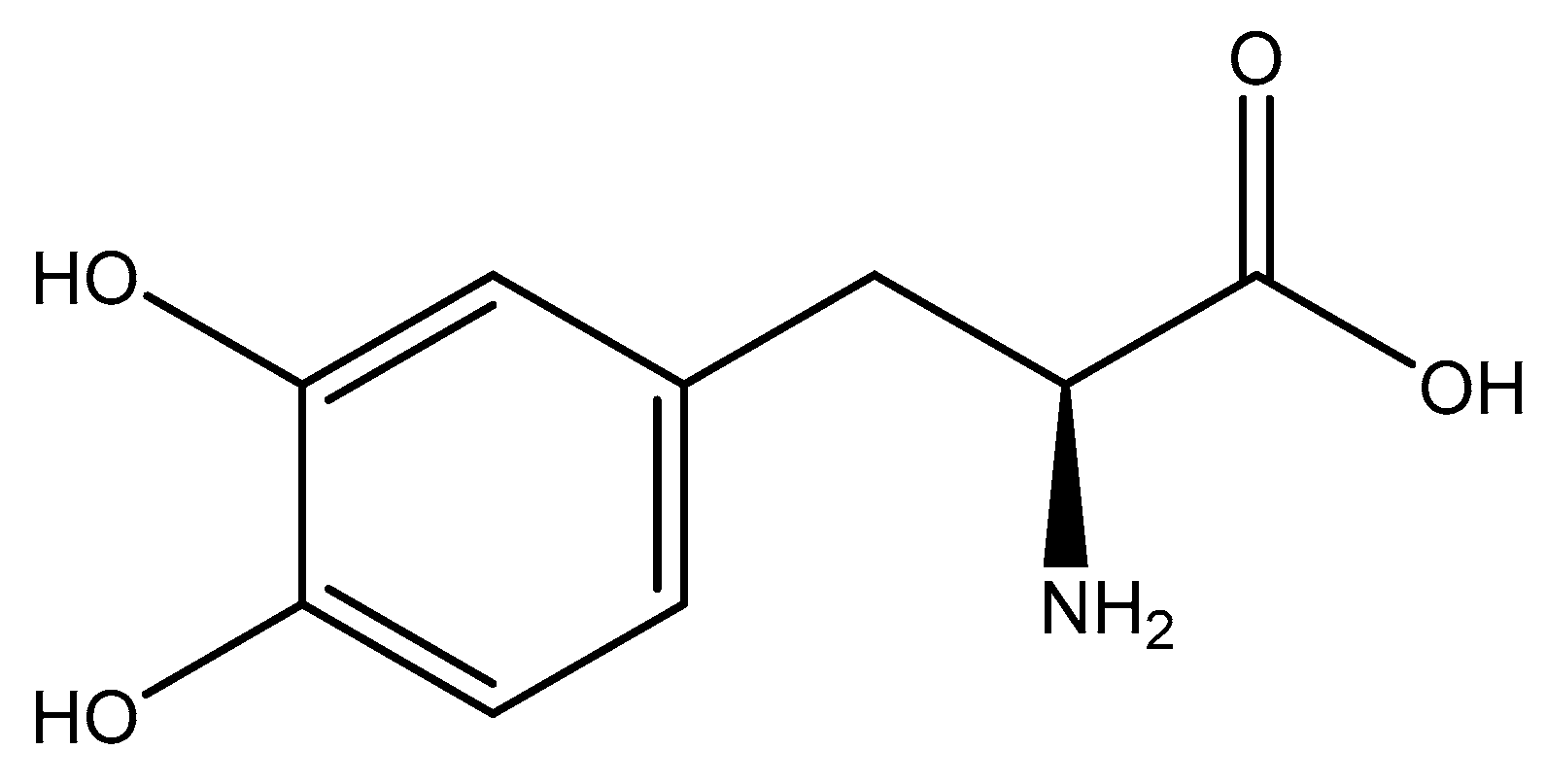
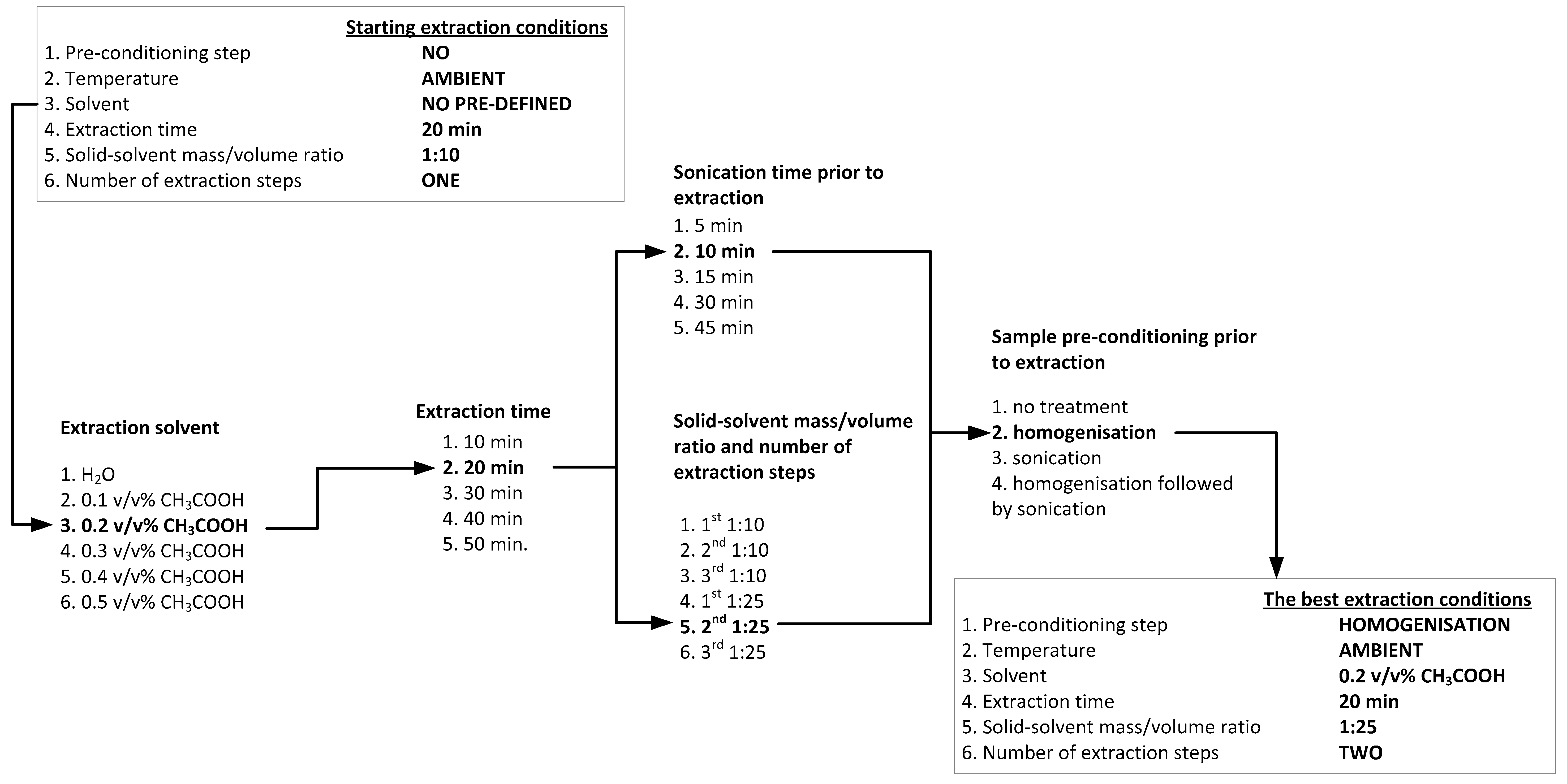
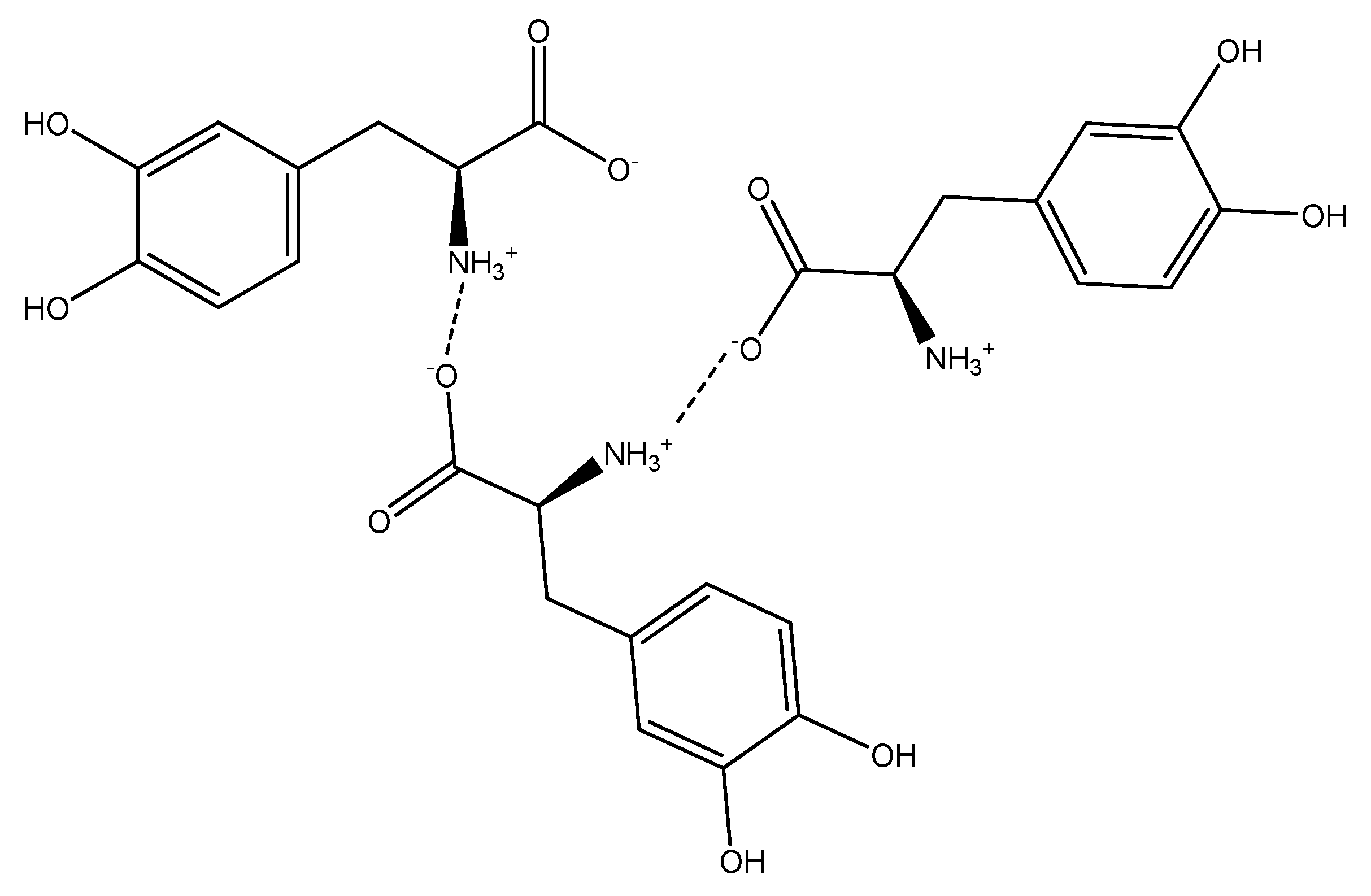
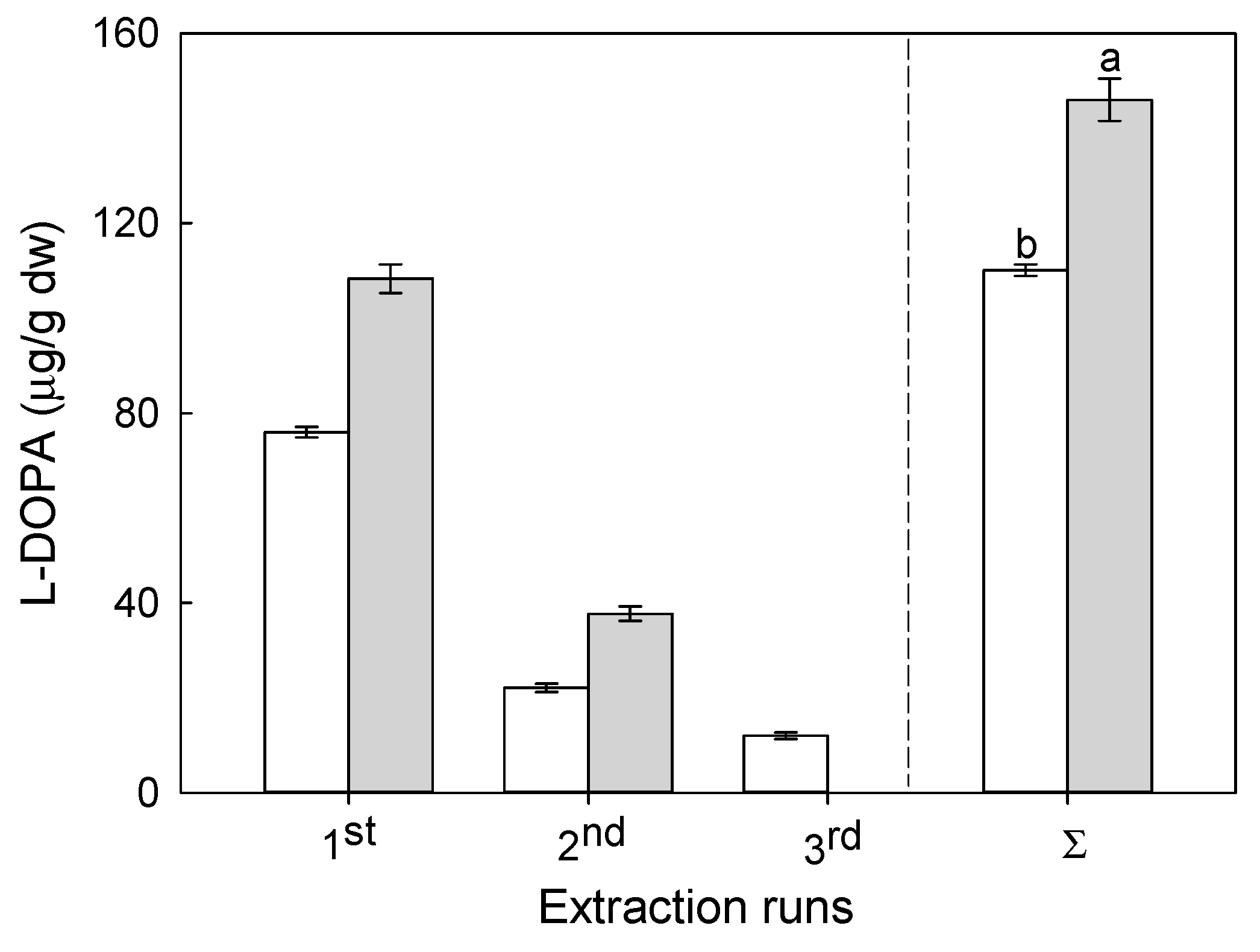
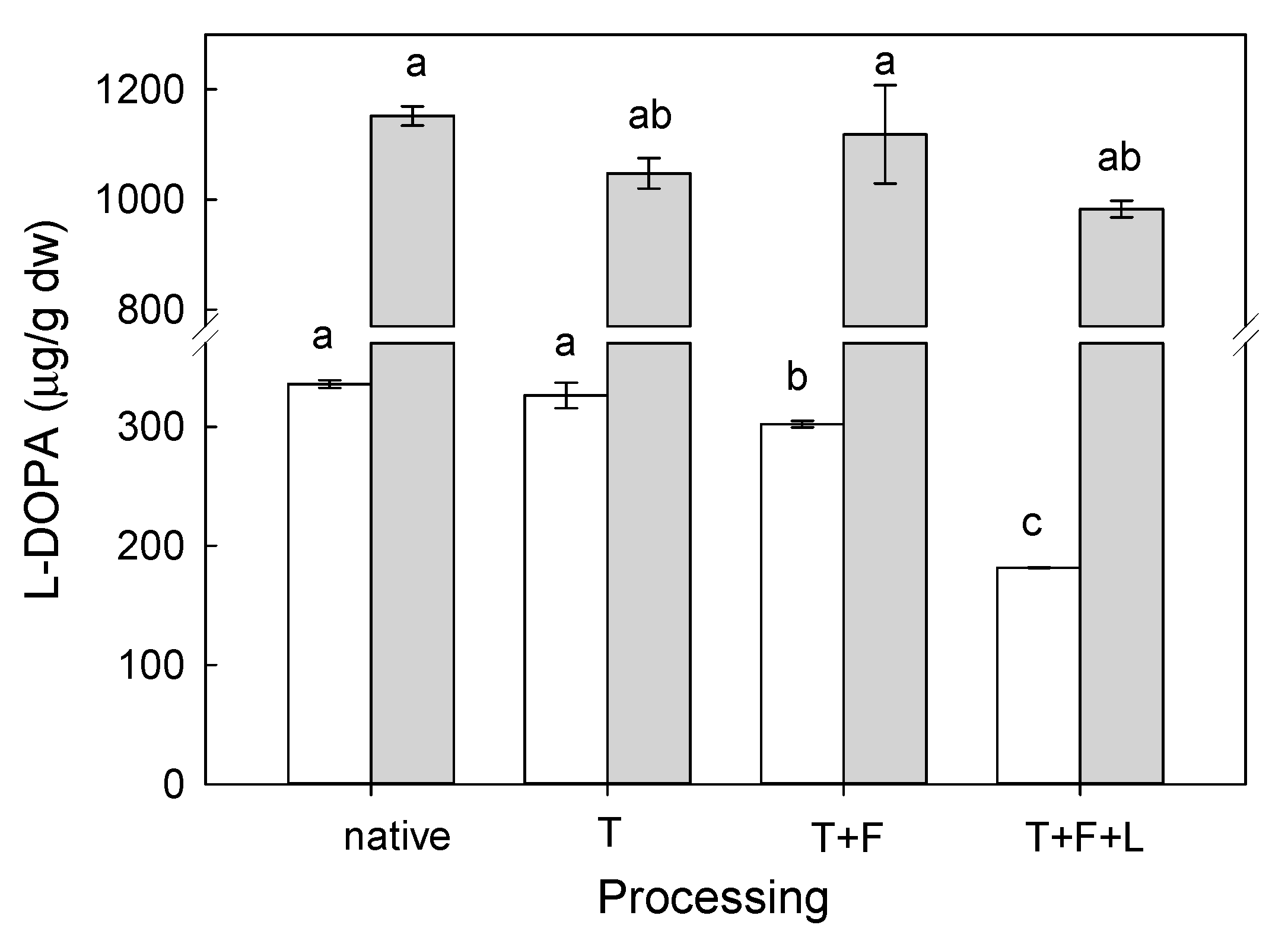
| Extraction Solvent | l-DOPA Content (µg/g dw) | pH |
|---|---|---|
| H2O | 25.2 ± 1.1 d | 6.20 |
| CH3COOH (0.1% v/v) | 72.1 ± 2.1 b | 4.80 |
| CH3COOH (0.2% v/v) | 77.5 ± 1.5 a | 4.66 |
| CH3COOH (0.3% v/v) | 77.8 ± 0.6 a | 4.36 |
| CH3COOH (0.4% v/v) | 71.7 ± 3.8 b | 4.23 |
| CH3COOH (0.5% v/v) | 62.2 ± 0.8 c | 4.18 |
| Time (min) | l-DOPA Content (µg/g dw) |
|---|---|
| 10 | 74.8 ± 1.4 ab |
| 20 | 77.5 ± 1.5 a |
| 30 | 75.4 ± 1.2 ab |
| 40 | 74.2 ± 2.9 ab |
| 60 | 71.9 ± 0.7 b |
| Pre-Conditioning | L-DOPA Content (µg/g dw) |
|---|---|
| No pre-conditioning applied | 146.0 ± 4.5 c |
| Homogenisation | 151.5 ± 5.1 a |
| Sonication | 135.7 ± 1.8 ab |
| Homogenisation proceeded by sonication | 124.2 ± 2.1 b |
| Variety | l-DOPA Content (µg/g dw) | Variety | l-DOPA Content (µg/g dw) |
|---|---|---|---|
| Bachus (M) | 151.5 ± 5.1 j | Amigo (m) | 421.8 ± 4.1 d |
| Bolero (M) | 335.8 ± 3.2 f | Olga (m) | 516.8 ± 5.9 c |
| White Windsor (M) | 191.5 ± 6.8 h | Granit (m) | 517.6 ± 3.0 c |
| Bonus (M) | 170.7 ± 4.4 i | Albus (m) | 382.2 ± 4.0 e |
| Rambo (M) | 225.2 ± 3.4 g | Fernando (m) | 1152.0 ± 17.6 a |
| Amulet (m) | 784.8 ± 7.9 b |
| Food Product | l-DOPA Content (µg/g dw) |
|---|---|
| Frozen | |
| K1 | 92.3 ± 5.3 a |
| K1 (C) | 6.3 ± 1.0 e |
| K2 | 29.7 ± 0.5 b |
| K2 (C) | 0.0 ± 0.0 f |
| K3 | 21.1 ± 1.5 cd |
| K3 (C) | 16.3 ± 0.9 d |
| Canned | |
| P1 | 24.0 ± 2.2 bc |
| P2 | 0.0 ± 0.0 f |
| P3 | 18.0 ± 1.3 d |
| Material Name | Humidity (wt%) | Material Name | Humidity (wt%) | ||
|---|---|---|---|---|---|
| V. faba var. minor | Frozen food | ||||
| Albus | 13.37 | K1 | 66.02 | ||
| Amigo | 12.77 | K2 | 67.43 | ||
| Amulet | 11.76 | K3 | 66.07 | ||
| Fernando | 12.57 | Canned food | |||
| Granit | 13.44 | P1 | 84.94 | ||
| Olga | 13.25 | P2 | 85.73 | ||
| V. faba var. major | P3 | 78.99 | |||
| Bachus | 9.56 | V. faba var. major cultivar Bolero | |||
| Bolero | 8.11 | autoclaved | 69.49 | ||
| Bonus | 10.34 | frozen | 69.91 | ||
| Rambo | 9.36 | lyophylised | 0.63 | ||
| White Windsor | 9.24 | V. faba var. minor cultivar Fernando | |||
| Velvet bean | 8.05 | autoclaved | 71.02 | ||
| frozen | 71.25 | ||||
| lyophilised | 0.64 | ||||
© 2019 by the authors. Licensee MDPI, Basel, Switzerland. This article is an open access article distributed under the terms and conditions of the Creative Commons Attribution (CC BY) license (http://creativecommons.org/licenses/by/4.0/).
Share and Cite
Polanowska, K.; Łukasik, R.M.; Kuligowski, M.; Nowak, J. Development of a Sustainable, Simple, and Robust Method for Efficient l-DOPA Extraction. Molecules 2019, 24, 2325. https://doi.org/10.3390/molecules24122325
Polanowska K, Łukasik RM, Kuligowski M, Nowak J. Development of a Sustainable, Simple, and Robust Method for Efficient l-DOPA Extraction. Molecules. 2019; 24(12):2325. https://doi.org/10.3390/molecules24122325
Chicago/Turabian StylePolanowska, Katarzyna, Rafal M. Łukasik, Maciej Kuligowski, and Jacek Nowak. 2019. "Development of a Sustainable, Simple, and Robust Method for Efficient l-DOPA Extraction" Molecules 24, no. 12: 2325. https://doi.org/10.3390/molecules24122325
APA StylePolanowska, K., Łukasik, R. M., Kuligowski, M., & Nowak, J. (2019). Development of a Sustainable, Simple, and Robust Method for Efficient l-DOPA Extraction. Molecules, 24(12), 2325. https://doi.org/10.3390/molecules24122325





